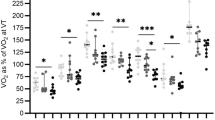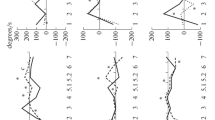Summary
In this study physical work capacity, mechanical efficiency on the bicycle ergometer and daily physical activities were compared between 24 physically handicapped and 24 non-handicapped children. As a measure of mechanical efficiency and physical work capacity, the oxygen uptake per kg body weight at 0.5 watt·kg−1 and oxygen uptake per kg body weight at a heart rate of 150 beats·min−1 were used. The daily physical activities were recorded during a 24-h period by means of a scoring list. The load imposed by the daily physical activities was investigated by registration of heart rate.
The mean value of the physical work capacity of the group of handicapped children was found to be lower compared with the non-handicapped children. The mechanical efficiency of 7 of the 24 handicapped children was lower when compared with the mechanical efficiency of 23 of the 24 non-handicapped children. A significant correlation between mechanical efficiency and nature of the handicap (spastic hemi-, di-, tetraplegic) was found (p<0.05). During light daily physical activities the handicapped children showed the same mean heart rate as the non-handicapped children, but the mean heart rate during heavy daily physical activities was lower for the handicapped group than for the non-handicapped group. The non-handicapped children spent more time in physical activities with relatively high heart rates.
From the results obtained of oxygen uptake and heart rate measurements it is to be expected that non-handicapped children are able to maintain a higher state of training by means of their daily physical activities than are handicapped children.
Similar content being viewed by others
References
Armitage P (1971) Statistical methods in medical research. Blackwell, Oxford Edinburgh
Astrand PO, Rodahl K (1977) Textbook of work physiology. McGraw-Hill, New York
Berg K (1970) Adaptation in cerebral palsy of body composition, nutrition and physical working capacity at school age. Acta Paediatr Scand [Suppl] 204: 1–93
Dukes MNG (ed) (1980) Meyler's side effects of drugs, 9th edn. Exerpta Medica, Amsterdam
Ekblom B, Lundberg A (1968) Effect of physical training on adolescents with severe motor handicaps. Acta Paediatr Scand 57: 17–23
Karvonen MJ, Kentala E, Mustala O (1975) The effects of training on heart rate. A longitudinal study. Ann Med Exp Fenn 35: 307–315
Knutsson E, Lewenhaupt-Olsson E, Thorsen M (1973) Physical work capacity and physical conditioning in paraplegic patients. Paraplegia 11: 205–216
Lundberg A, Ovenfors CO, Saltin B (1967) Effect of physical training on chool-children with cerebral palsy. Acta Paediatr Scand 56: 182–188
Lundberg A, Pernow B (1970) The effect of physical training on oxygen utilization and lactate formation in the exercising muscle of adolescents with motor handicaps. Scand J Clin Lab Invest 26: 89–96
Lundberg A (1975) Mechanical efficiency in bicycle ergometer work of young adults with cerebral palsy. Dev Med Child Neurol 17: 434–439
Rutenfranz J, Seliger V, Lange Andersen K, Ilmarinen J, Berndt I, Knauth P (1975) Differences in maximal aerobic power related to the daily physical activity in childhood. In: Borg G (ed) Physical work and effort. Pergamon Press, Oxford, pp 279–288
Saltin B, Blomqvist G, Mitchell JH, Johnson RL, Wildenthal K, Chapman CB (1968) Response to exercise after bed rest and after training. Circulation [Suppl 7] 38: 1–78
Saris WHM, Snel P, Baecke J, Waesberghe van F, Binkhorst RA (1977) A portable miniature solid-state heart rate recorder for monitoring daily physical activity. Biotelemetry 4: 131–140
Saris WHM, Binkhorst RA, Cramwinckel AB, Waesberghe van F, Veen van der-Hezemans AM (1980) The relationship between working performance, daily physical activity, fatness, blood lipids, and nutrition in school-children. In: Berg K, Eriksson BO (eds) Children and exercise, vol 10. International Series on sport sciences. University Park Press, Baltimore, pp 166–174
Siegel S (1956) Nonparametric statistics for the behavioral sciences. McGraw-Hill, Kogakusha
Author information
Authors and Affiliations
Rights and permissions
About this article
Cite this article
Dresen, M.H.W., de Groot, G., Brandt Corstius, J.J. et al. Physical work capacity and daily physical activities of handicapped and non-handicapped children. Europ. J. Appl. Physiol. 48, 241–251 (1982). https://doi.org/10.1007/BF00422985
Accepted:
Issue Date:
DOI: https://doi.org/10.1007/BF00422985




